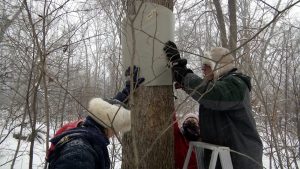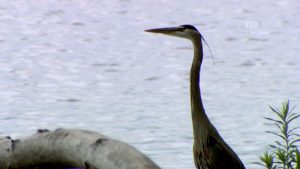“It’s a shy bird,” said volunteer Barbara Bor of the blue heron. “It’s beautiful, a good fisher. Really, when you look at the massive amount of work they put into their nests, I’m sure they appreciate what we’re doing.”
For about a dozen years, the volunteers have surveyed the nests on the island and attached metal flashing around the trunks of the trees with nests so predators–primarily raccoons–can’t attack the nests and eat the baby herons.
“It’s really just believing that, even though it’s a tiny contribution, you make a difference and you care about these wonderful birds,” said Bor.
She said the core group of volunteers come from past posts on the City of Lino Lakes Environmental Board and also includes the city’s enivronmental coordinator, Marty Asleson.
“Then they bring a neighbor or somebody who’s interested,” said Bor . “So, it perpetuates with environmental passion.”

Volunteers secure metal flashing meant to protect heron nests from predators on an island in Peltier Lake near Lino Lakes.
The group tries to get to the island in the winter while the birds are away. Asleson said the herons usually return to nest in the area around St. Patrick’s Day every year.
“The (nests) that are outside the perimeter (of the core of the island rookery) that are flashed are newer and they’re large,” said Asleson as he examined the progress. “They don’t look like they’ve been predated (by mammals.).”
Bor said a study by a University of Minnesota graduate student about a decade ago found that the nests had come and gone with development near the island shifting and changing. Once he put up video cameras near the nests, he found that the nests that were there were quickly becoming victims to predators.
“It went down to 30 nests and now we’re at about 300,” she said.

The blue heron is the symbol of the City of Lino Lakes, and hundreds of them nest each year on Peltier Lake
Now, the next problem that arises may be another factor beyond the group’s control.
“Our worry now is that these are primarily ash trees (that hold the nests), and if the emerald ash borer invades, then what?” Bor said.
“Nature takes its course,” she said. “Some things you can influence, and the predation you can influence.”


